Published Abstracts by Nick Marsico
The current study explored the situational contexts of marijuana and alcohol use among late adole... more The current study explored the situational contexts of marijuana and alcohol use among late adolescents in states where recreational marijuana is legal. Participants (N = 101; 55% women, 35% men, 9% trans identified; 75% Caucasian; 12% latinx) were 18-20 year-old current marijuana users living in the greater Portland, Oregon-Vancouver, Washington metro area.
Conference Presentations by Nick Marsico

The current study explored the situational contexts of marijuana and alcohol use among late adole... more The current study explored the situational contexts of marijuana and alcohol use among late adolescents in states where recreational marijuana is legal. Participants (N = 101; 55% women, 35% men, 9% trans identified; 75% Caucasian; 12% latinx) were 18-20 year-old current marijuana users living in the greater Portland, Oregon-Vancouver, Washington metro area. Participants completed indices of marijuana (Marijuana Smoking History Questionnaire) and alcohol use (Q/F), motives to use or abstain (Marijuana Motives Measure; Motivational Questionnaire for Abstaining from Marijuana), and contexts of use (Inventory of Marijuana Situations; Social Contexts of Marijuana Scale) online. Forty-four percent of this sample used cannabis weekly, with 23% using daily. Marijuana was commonly smoked or vaporized an average of two times per day on using days, with approximately 0.15 grams used at each time. Among those who used cannabis orally (74%), consumption occurred less than once a month, and less than half of participants (48%) endorsed the use of cannabis concentrates such as hash, oil, or wax. Marijuana was generally obtained from a friend or other contact (93%), with the second most frequently endorsed method of accessing marijuana being a recreational dispensary (24%). Youth reported enhancement, coping, and expansion motives for marijuana use at the highest level, followed by social and conformity reasons. Abstaining for reasons of lack of interest or impracticality had the greatest endorsement in this sample. In terms of contexts of use, youth most commonly used marijuana for social facilitation, followed by coping with emotional pain. Linking marijuana use to alcohol use, it was found that 86% of these participants drank alcohol in addition to smoking marijuana; drinkers consumed alcohol weekly and drank 3.2 drinks on average (SD = 1.4). This preliminary data gives us more insight into patterns, motives, and contexts of use for underage youth in recreational legal states, and further examines the connections between alcohol and marijuana use. In the future, a better understanding of these factors may be useful in developing more effective prevention programs for marijuana and alcohol use that focus on situational precursors of use.
Clinical Psychology and Psychopathology by Nick Marsico
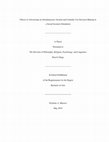
It is clear that heavy alcohol and cannabis use is a public health risk with relatively high prev... more It is clear that heavy alcohol and cannabis use is a public health risk with relatively high prevalence rates and varied consequences, especially with regards to underage populations. Decision-making to engage in these substances is manipulated and heavily influenced by the advertising industries of both alcohol and cannabis (albeit quite new), especially through branding and various other appeals present on social media. Simultaneous alcohol and marijuana (SAM) use, another public health concern, may also be impacted by advertising. The aim of the current study is to determine how a variety of advertisements affect behavioral willingness (BW) to use alcohol and cannabis as shown through the Can-SIDE audio simulation, an analog of alcohol and marijuana use behavior. In a sample (N = 57) that was predominantly women, White, and had an average age of 20.6 years (SD = 1.75), participants were exposed to an advertising prime of either alcohol, cannabis, or alcohol and cannabis. They then completed a version of the Can-SIDE simulation in which BW for alcohol, cannabis, and controls in a variety of situations was self-reported. Participants then completed measures of demographics, past exposure to advertising, receptiveness of advertising, and alcohol and cannabis use history. While successful randomization occurred and the Can-SIDE performed similarly to past studies, BW to accept alcohol and cannabis offers did not differ on the basis of the advertising prime. However, BW to accept control offers was significantly higher in the alcohol and cannabis ad group when compared to the cannabis ad prime. This study yielded mixed results; as the hypotheses were not supported, it is an open question whether alcohol and cannabis advertising does impact the simultaneous use of these agents. Further research is needed to determine how outside forces such as advertising contribute to decision-making, and how such decision-making may lead to the use agents with potentially negative consequences.
Past research has demonstrated that simultaneous alcohol and marijuana (SAM) use has been linked ... more Past research has demonstrated that simultaneous alcohol and marijuana (SAM) use has been linked to strong negative consequences, particularly driving under the influence (Terry-
This bibliography has been conducted to review the literature on the effect of alcohol use on maj... more This bibliography has been conducted to review the literature on the effect of alcohol use on major depressive symptoms in in youth aged 10-25. It has been conducted using the database PsycInfo, using search keywords (alcohol or alcoholism or alcohol abuse or alcohol misuse or binge drinking) AND (depression or depressive disorder or depressive symptoms or major depressive disorder) AND (youth or adolescents or young people or teens or young adults). I’ve narrowed down the search to the pertinent literature of 6 sources only by limiting my publication type to peer-reviewed journals only and journals with linked full text only, by ordering in order of “relevance” and then choosing the most relevant literature to my prompt by reading abstracts of the first few pages in which my keyword search found (studies that have a main focus on depression relating to alcohol use in youth).
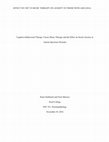
Children diagnosed with autism have been shown to have trouble forming relationships in the early... more Children diagnosed with autism have been shown to have trouble forming relationships in the early years of schooling (Fuji et al., 2016). In addition, clinically elevated anxiety is common among adolescents with autism spectrum disorder (Wood et al., 2015). Music therapy, cognitive-behavioral therapy (CBT), and different treatment settings have found significant results in children with autism (Allgood, 2005; de Groot, Cobham, Leong, & McDermott, 2007; Geretsegger, Holck, Bieleninik, & Gold, 2016), but there is not one concise agreement on what the best treatment is (Silverman, 2008). Based on this literature review, we aim to determine how efficacious different treatments are in those with autism spectrum disorder (ASD) in relation to social anxiety. We will use a 2 x 2 x 2 design to vary type of treatment (music/CBT), type of setting (group/individual), and diagnosis of participant (ASD/control). Around 150 participants from kindergarten classes in Portland, Oregon will complete a year-long therapy program that meets once a week. Measures regarding ASD diagnosis, social behaviors, developmental history, and anxiety will be recorded pre- and post-treatment. We expect to find that music therapy will have a more immediate effect while CBT will have a more long-term effect on decreasing social anxiety, and that individual therapy will have a more immediate effect while there will be no differences between individual and group settings long-term.
Study Abroad - France by Nick Marsico
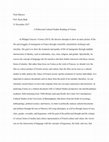
In Philippe Faucon 's Fatima (2015), the director attempts to show an inner picture of the life a... more In Philippe Faucon 's Fatima (2015), the director attempts to show an inner picture of the life and struggles of immigrants in France through a heartfelt, minimalistic technique and storyline. His goal is to show the treatment and quality of life of immigrants through multiple intersections of identity, such as nationality, race, class, religion, and gender. Specifically, he weaves the concept of language into his narrative that then further intersects with these various forms of identity. But rather than focus on Fatima as the work of Faucon, we should view the film as a direct product of French society and culture; thus the film can be seen as a cultural artifact to fully analyze the values of French society and the treatment of various individuals. It is important to analyze documents such as these from the point of an outsider; therefore, we can eliminate current biases we have that originate from our own past experiences and memories. In analyzing Fatima as a cultural document with a Cultural Studies perspective (an interdisciplinary academic field stemming from 1960s Britain (and specifically the Center for Contemporary Cultural Studies at the University of Birmingham), that draws from the fields of sociology, anthropology, political science, and history, in order to politically analyze cultural documents and artifacts through the lens of Marxist, left-wing ideologies, as well as through lenses of race, class, gender, sexuality, and hegemony, with the goal of the politicized thought and the critique of various forms of media) and a direct representation of French culture and values, the viewer can see the intersection of language with the concepts of hegemony, the body, and race, that
On peut déduire que toutes les espèces ont la capacité de représentation mentale et dans quelles ... more On peut déduire que toutes les espèces ont la capacité de représentation mentale et dans quelles circonstances on a la capacité de comprendre le mouvement dans le temps et l'espace des objets ? De nombreuses questions sont soulevées avec des comparaisons entre espèces, et il n'y a aucun moyen de dire la présence de la permanence de l'objet dans des populations sans langue. Tout en étant fiables et valides, ces expériences soulèvent toujours la question de la causalité.
Dans « L’enfant d’âge scolaire : raisons cognitives et raisons sociales », un extrait de Les Étap... more Dans « L’enfant d’âge scolaire : raisons cognitives et raisons sociales », un extrait de Les Étapes de la sociabilité (1952) par Henri Wallon, l’auteur décrit comment un enfant grandit intellectuellement et socialement au début du temps quand la scolarité devient obligatoire (l’âge de six à sept ans). L’extrait, qui est vraiment Wallonian, présente beaucoup de thèmes récurrent que Wallon a étudié, comme les liens entre la personnalité, l’intelligence, et la sociabilité ; la relation entre l’enfant et ses parents tout au long des années de l’enfance ; et la réciprocité d’enfant et les rapports aux autres.
Dans les différents œuvres de Vincent Van Gogh (1853-1890), un peintre hollandais Postimpressionn... more Dans les différents œuvres de Vincent Van Gogh (1853-1890), un peintre hollandais Postimpressionniste, on peut voir la tourmente mentale qui finissent par entraîner son suicide en 1890. De nombreux théoriciens ont de vastes théories sur ses conditions, mais il est généralement admis qu'il a lutté contre la dépression tout au long de sa vie. Comme le montrent les théoriciens, une analyse plus approfondie des styles de peinture, des représentations de la vie idyllique et des couleurs dans les œuvres de Van Gogh illustre un sentiment plus profond d'émotion sombre et de personnalité dans sa vie.
French Literature by Nick Marsico
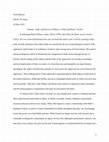
Trauma, Truth, and Power in NDiaye's Hilda and Duras' Ourika In analyzing Marie NDiaye's play, Hi... more Trauma, Truth, and Power in NDiaye's Hilda and Duras' Ourika In analyzing Marie NDiaye's play, Hilda (1999), and Claire de Duras' novel, Ourika (1823), the two works demonstrate how one can bend the truth to one's will by creating a false truth. In both situations, these false truths are asserted by the use of psychological control of the oppressed, which leads to an imbalance of power and a strong sense of lived trauma. This power and psychological control is obtained by the antagonists of both stories through the use of rhetoric and the taking of the culture and the body of the oppressed. In viewing overarching political implications of these accounts, it is clear that race and inequality are major themes throughout; the authors of both tales attempt to convey how the oppressed are worn down by the oppressors. This breaking down of the oppressed is demonstrated by both authors in that both of the titular characters, Hilda and Ourika, end up in a damaged mental state in which recovery may not be possible. Therefore, both NDiaye and Duras warn readers of oppressive power dynamics and the strong negative consequences that may be associated with them.
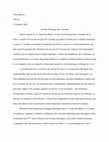
Dans le poème de « L'heure du sabbat » d'Aloysius Bertrand dans « Gaspard de la Nuit », le poète ... more Dans le poème de « L'heure du sabbat » d'Aloysius Bertrand dans « Gaspard de la Nuit », le poète crée un sens de peur de l'inconnu qui guide le lecteur par les strophes du poème en prose. L'inconnu correspond à l'expérience du lecteur, comme il s'oriente quand lisant une pièce pour la première fois. Bertrand crée un sens de l'inconnu par l'absence de la description explicite, qui est supportée par la langue figurative, comme des métaphores, de la répétition, de la personnification, et d'autres dispositifs littéraires. En addition, Bertrand utilise un binaire entre la vie composée et la vie naturelle et brute pour montrer le côté fantastique et étrange de la vie. L'inconnu peut être vu à travers du concept de deixis. Les expressions déictiques sont situationnelles, dans le sens où ils décrivent le temps, le lieu, les objets, et les personnes. Les mots déictiques peuvent être divisés dans les mots déictiques de temps (maintenant, quand, hier, etc.) et de lieu (ici, là, etc.). Ils ont besoin plus d'informations supplémentaires de leur contexte pour être compris. Par exemple, quand le lecteur lit « Il ira là demain », des sentiments d'incertitude se posent, comme le lecteur ne sait pas qui est référencé, quel lieu est référencé, et quel jour ou demain est fait référencé. Afin de bien comprendre les mots déictiques tels que ceux dans cette phrase, nous avons besoin d'une connaissance descriptive avant lire la phrase. Bertrand insère beaucoup de langages déictiques dans « L'heure du sabbat », et il ajoute un sentiment cryptique à l'histoire, conduisant à des éléments fantastiques qui sont apparus dans la littérature du 19 ème siècle. On peut voir les mots déictiques avant même le début du poème.
Dans la nouvelle L'Hôte d'Albert Camus, il y a deux personnages qui semblent très différents. L'i... more Dans la nouvelle L'Hôte d'Albert Camus, il y a deux personnages qui semblent très différents. L'instituteur, qui s'appelle Daru, et l'Arabe, dont on ne connaît pas le nom, viennent de différents horizons, mais le but de Camus est de nous montrer qu'ils sont les mêmes. L'Hôte est un récit sur la similarité inéluctable de la nature humaine; il décrit progressivement que nous avons tous des sentiments, des actions et des pensées selon les mêmes processus, et à la fin que nous formons une même communauté d'être humains.

Uploads
Published Abstracts by Nick Marsico
Conference Presentations by Nick Marsico
Clinical Psychology and Psychopathology by Nick Marsico
Study Abroad - France by Nick Marsico
French Literature by Nick Marsico